Key steps
To reliably sex and age grey partridges, the following five features should be examined together:
- Head feathering and bill colour
- Wing covert pattern
- Shape of primary feathers
- Leg colour
Sexing
A. Facial features of adult birds
In the hand, adult male and female grey partridges are separated using differences in facial features and in the patterning on the scapulars, lesser and median wing-coverts. Males have an orange-buff face, long supercilium and throat with clearly visible reddish bare skin above, behind and below the eye. The latter is most prominent and bright red in late winter/spring and usually much smaller and faded in autumn. Females typically have an orange-brown face and a white supercilium. However, some females lack a whitish supercilium and others have more of a whitish rather than brown face. Bill colour in adult birds is medium grey tinged horn-brown.
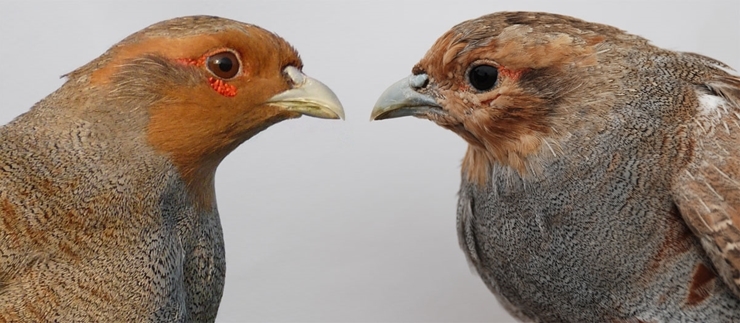
Figure 1.
Left: Adult male on 1 April (age code 6). Bird in complete breeding plumage. Note bright red-coloured bare skin around eye, uniformly orange-buff facial feathers and olive-brown ear-coverts. (Photo credit: Eckhard Gottschalk)
Right: Adult male on 2 October (age code 4). Bird in active body moult. Very worn pale orange facial feathers (forehead, eye-streak, throat) clearly contrasting with cinnamon-coloured new feathers (lores and cheek). At this stage, males with heavily worn plumage may be confused with females based on facial features alone (especially females without a white supercilium). (Photo credit: Francis Buner)
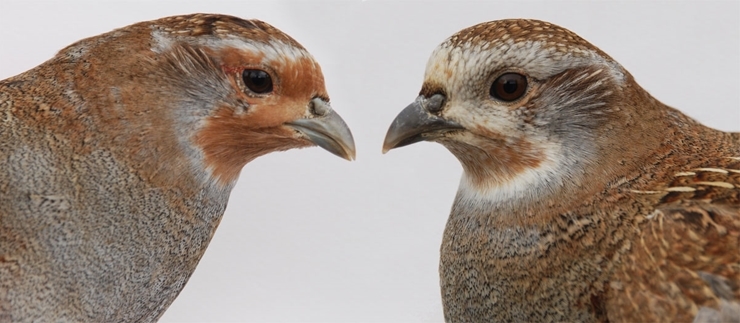
Figure 2.
Left: Adult female 7 January (age code 6). Typical adult female in complete winter plumage with prominent white supercilium and orange-brown face and throat. Note medium grey bill tinged horn-brown, typical for adults from second calendar year onwards. (Photo credit: Francis Buner)
Right: Juvenile female 16 October (age code 3). Unusually whitish-faced female after complete post-juvenile moult (all facial feathers adult). Note the dark-coloured beak, typical for juvenile birds in their first calendar year. (Photo credit: Francis Buner)
B. ‘Cross of Lorraine’
In the hand, male and female grey partridges are most reliably sexed from the pattern of barring on the scapulars (shoulder coverts).
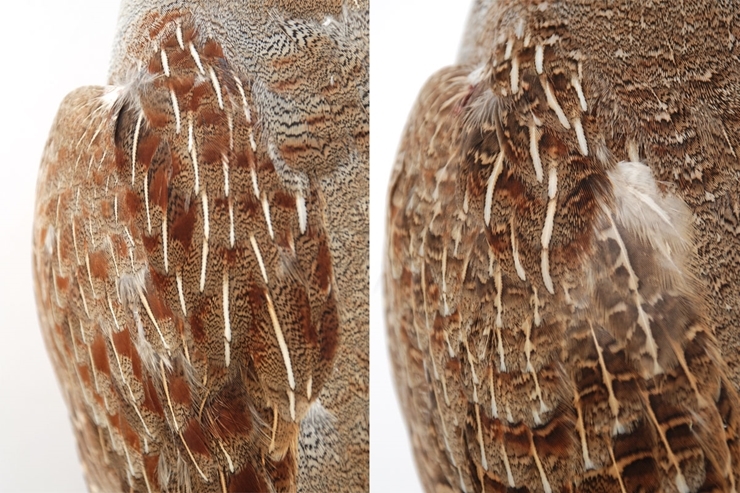
Figure 3.
Left: Male scapulars are finely vermiculated buff or grey-buff, with large chestnut dots on sides (absent in some) and long, distinct, off-white shaft streaks with no pale cross bars associated with them. (Photo credit: Francis Buner)
Right: Female scapulars have distinct cross bars also called the ‘Cross of Lorraine’ branching off the central buff-white shaft streak. The difference in barring is also clearly visible on the lesser and median wing-coverts. (Photo credit: Francis Buner)
C. The horseshoe
All males have a prominent, well-defined chestnut-brown or black patch (‘horseshoe’) on a pale belly whereas females usually have only a few black spots on a white belly (in c. 15% it is absent). Some females, however (especially older adults), have a small or even large horseshoe, so presence or absence of a horseshoe is not a reliable indicator of sex. Therefore, in the hand checking the scapular pattern is always necessary.
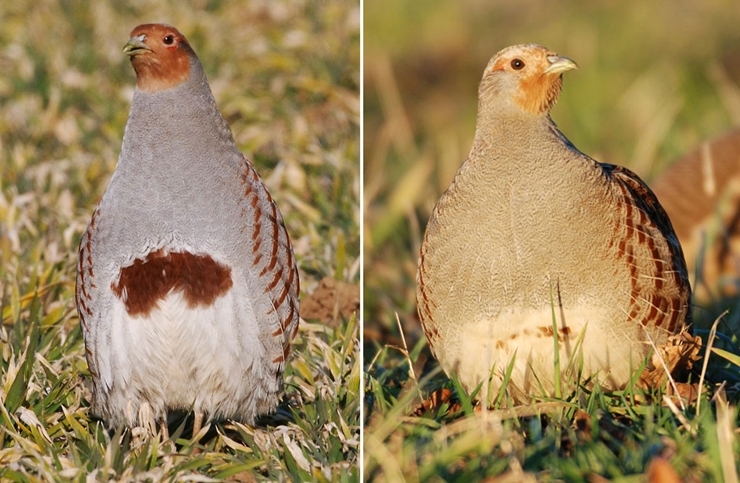
Figure 4.
Left: Male with typical horseshoe. (Photo credit: Markus Jenny)
Right: Female with much attenuated horseshoe. (Photo credit: Markus Jenny)
D. Sexing juveniles in post-juvenile moult
In the hand as in the field, birds in juvenile plumage cannot be sexed. However, once post-juvenile moult has progressed to the stage when the first adult characteristics are acquired, sexing becomes possible, particularly in the hand. Care must be taken in the field, especially when body moult has just started, as facial features of juveniles and females can look very similar at a distance. Once head moult is half-way complete (typically in September-October at an age of 10-11 weeks), sexing is feasible also in the field.
Males always have more orange facial feathers than females and never a white supercilium. The bill colour of juveniles is dark slate-grey. In the hand, always double check with the ‘Cross of Lorraine’ scapular pattern, shape of primaries and leg colour.
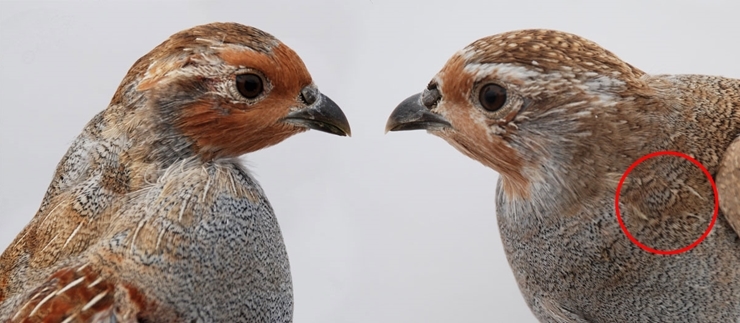
Figure 5.
Left: Juvenile male on 2 October (age code 3) in active post-juvenile moult. Note new orange-buff facial feathers, including wide but incomplete supercilium. Feathers behind eye and crown in active moult or still juvenile. White-steaked brown juvenile feathers in neck area clearly contrast with new grey adult plumage. Note also dark juvenile beak. (Photo credit: Francis Buner)
Right: Juvenile female on 7 January (age code 5) in almost complete adult plumage. Moult of ear-coverts halfway complete and faded orange-brown juvenile feathers between eye and lower mandible contrast with darker orange/brown adult feathers on forehead and throat. Also, two juvenile white-streaked feathers still remain on side of upper breast (encircled in red). (Photo credit: Francis Buner)
Ageing
A. Plumage and moult
Juvenile body plumage is almost complete at four weeks, but the tail not before six weeks. Post-juvenile body moult starts with inner primary (P1) at an age of four to five weeks. Body moult starts at six to seven weeks with the back feathers and flanks. The moult of the scapulars and lesser coverts starts at an age of eight weeks. The breast feathers’ moult, including the horseshoe, is completed at nine to 10 weeks. Head moult starts at 10 weeks and the adult facial feathers are fully acquired at an age of 13 weeks. Juvenile moult is complete at 17 weeks in October-November (extremes in January), except for the outer two primaries (P9 and P10) which are retained until at least September in the second calendar year.
Adults undergo a complete post-breeding moult, which starts with P1 in mid-June or early July (in females when eggs hatch), with some as late as early August. It typically finishes with outer primaries in early November. Ageing after complete post-juvenile moult is done based on the shape of the tips of primaries P9 and P10. In adults all primary tips are rounded, whereas the retained outermost primaries P9 and P10 of juveniles (age code 3 or 5, depending on date of catch) are more narrow and pointed than those of adults.
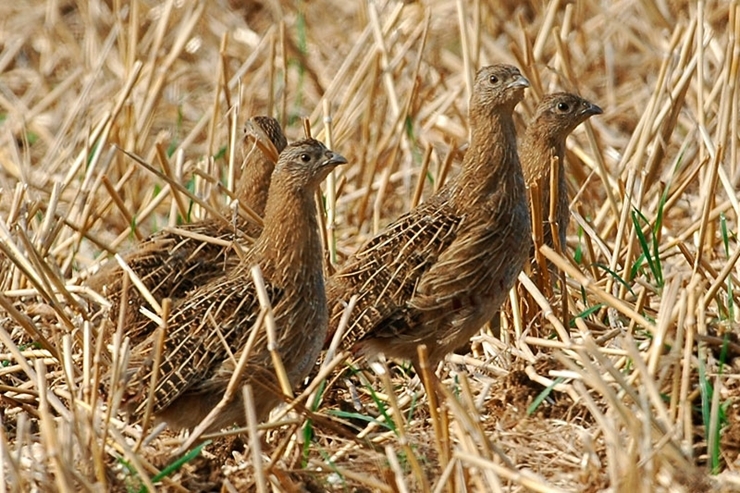
Figure 6. Grey partridges in juvenile plumage at an age of six to seven weeks, 19 August. Birds are mostly in juvenile plumage with crown and sides of the head still dark sepia, finely streaked off-white. Neck, mantle, chest and flanks buff-brown with pale buff shaft-streaks. Scapulars and tertials are dull black with pale buff bars and shaft-streaks. Lesser and median upper wing coverts are brown with pale buff shaft-streaks and broad buff edges. Note started body moult on lower flanks and upper breast. Birds at this age cannot be sexed. (Photo credit: Markus Jenny)
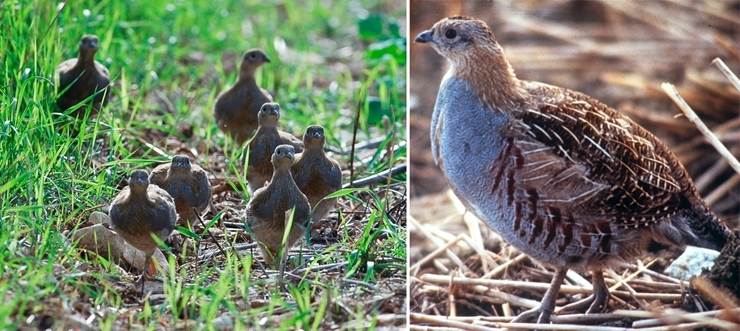
Figure 7.
Left: Grey partridges in juvenile plumage at an age of seven to eight weeks, 26 August. Birds still mostly in juvenile plumage but moult of breast more advanced than in Figure 6, showing more adult grey feathers. Note that the lower breast feathers at this age are still juvenile together with scapulars and wing coverts (not visible in this photo), and hence sexing is still not possible. (Photo credit: Markus Jenny)
Right: Grey partridge juvenile at an age of nine to 10 weeks. Flank and breast feathers predominantly adult with only a few streaked buff-brown juvenile feathers remaining on upper flank. In the wing, the new darker lesser and median coverts contrast with the paler buff-steaked juvenile feathers. Scapulars are still juvenile. (The lack of a horseshoe and the presence of the ‘Cross of Lorraine’ pattern in the new wing coverts identifies this bird as a female). (Photo credit: Alexis de la Serre)
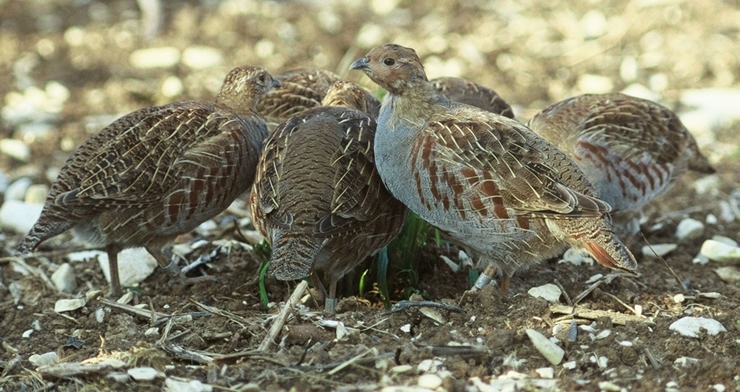
Figure 8. Covey of juvenile grey partridges at an age of approximately 12 weeks. Foreground birds from left to right:
- Female (note still incomplete moult of head and neck, showing predominantly juvenile plumage, but white supercilium together with female pattern on scapulars).
- Male
- Male (note male pattern on scapulars in both birds and almost complete moult of facial feathers, but neck feathers still mostly juvenile).
Also note yellowish legs of all birds. (Photo credit: Francis Buner)
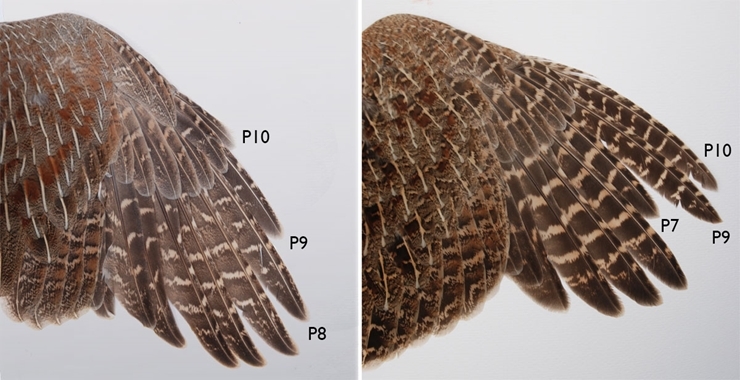
Figure 9.
Left: Wing of adult, 2 October (age code 4). Outermost primaries P8, P9 and P10 still growing and clearly rounded. (Note the distinct off-white shafts-streaks of the lesser and median wing-coverts identifying this bird as a male.) (Photo credit: Francis Buner)
Right: Wing of juvenile, 2 October (age code 3). P7 growing, P8 in pin and not visible, P9 and P10 are retained juvenile feathers and clearly pointed, rest of the wing is adult. Also note the bar pattern on P9 and 10 is tighter on the juvenile feathers than on the adult primaries 1-7. (The ‘Cross of Lorraine’ pattern on the median and lesser coverts identifies this bird as female.) (Photo credit: Francis Buner)
B. Leg colour
Juveniles (age code 3) can also be aged on leg colour, which is yellow-brown. Birds entering their second calendar year (age code 5) gradually change their leg colour to grey by mid to late winter, so from January onwards, leg colour should not be used to age birds.
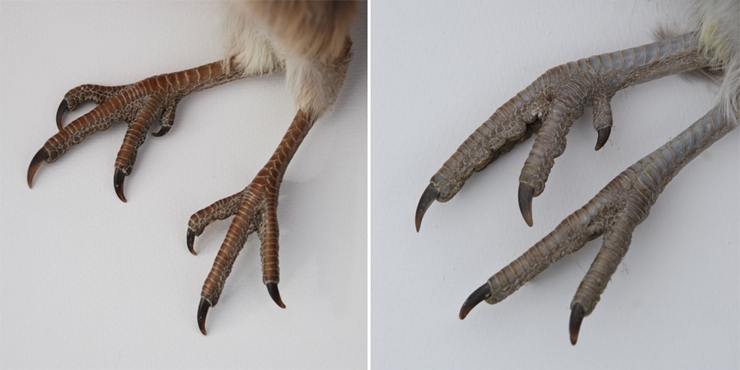
Figure 10.
Left: Juvenile with yellowish legs. (Photo credit: Francis Buner)
Right: Adult with grey legs. (Photo credit: Francis Buner)
Wild or reared?
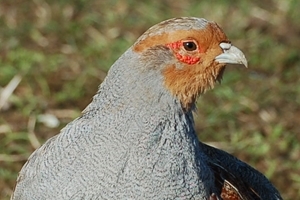 In the UK, small numbers of reared grey partridges are released every year for shooting or restocking. For recommendations on how to release grey partridges for conservation purposes see our guidelines, Re-establishing Grey Partridges Through Releasing.
In the UK, small numbers of reared grey partridges are released every year for shooting or restocking. For recommendations on how to release grey partridges for conservation purposes see our guidelines, Re-establishing Grey Partridges Through Releasing.
In the field, released birds from game farms are often recognisable from their tame behaviour, unnaturally large group size and ‘raptor-like’ bill shape. The upper mandible in reared birds is often noticeably longer than the lower mandible giving it a raptor-like look (see photo, left). This is caused by the provision of pure pelleted food with little opportunity to wear the bill down. In the hand one can often see some heavy wear on the tips of the primaries, caused by walking up and down the sides of wire mesh pen sections.
Reared birds should never be ringed.
References and acknowledgements
- The Game Conservancy (1977). Game Records, Techniques for census, ageing and sexing, Booklet 9. The Game Conservancy, Fordingbridge, UK.
- Birkan, M.G. (1977). Reconnaissance du sexe et de l’âge chez la Perdrix grise (Perdix perdix L.) et la Perdrix rouge (Alectoris rufa L.), Pp. 23-54 in P. Pesson and M.G. Birkan, eds. Écologie du petit gibier et aménagement des chasses. Gauthier-Villars, Paris.
- Cramp, S. and Simmons, K.E.L. (eds.) (1979). The Birds of the Western Palearctic, Vol. II. Oxford University Press, Oxford.
- The author would like to thank Nicholas Aebischer, Tim Walker, Dan Hoare and Sophie Barker for their valuable comments, as well as the photographers.